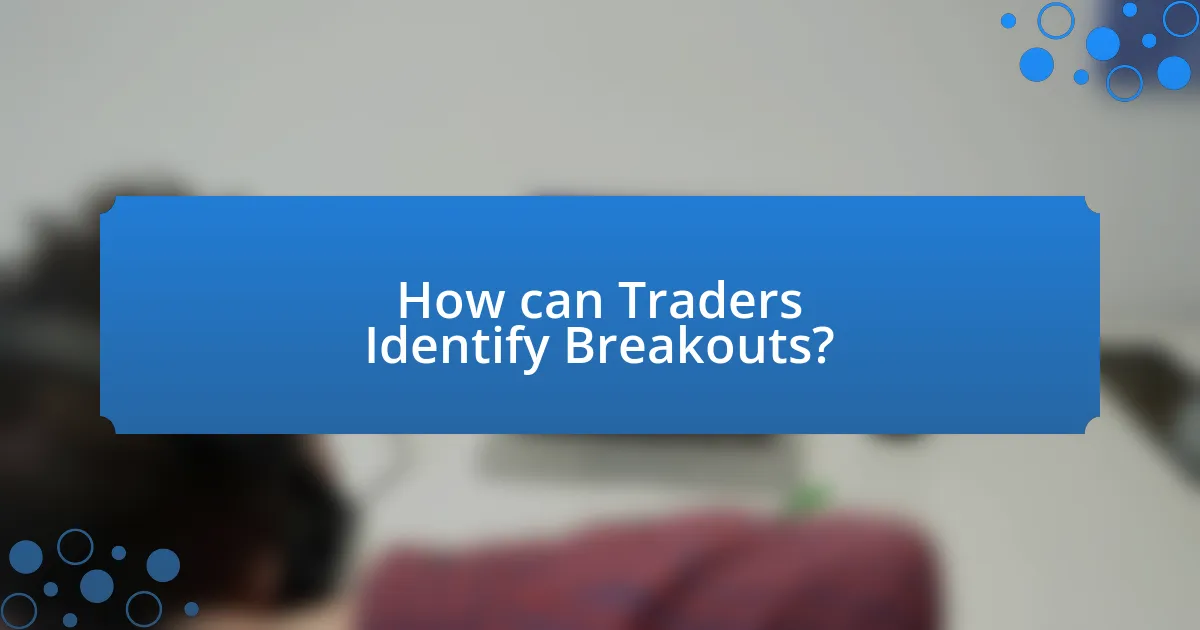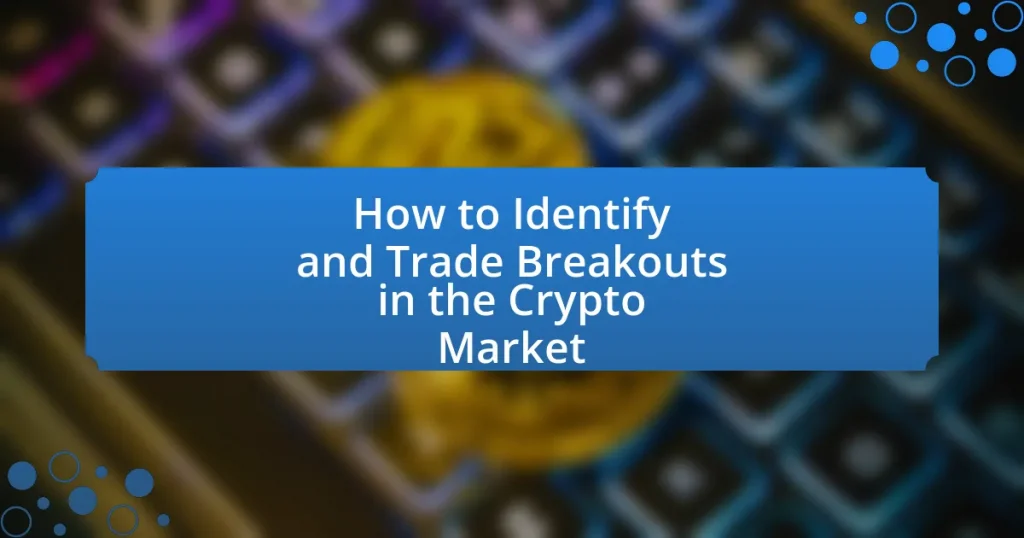The article focuses on identifying and trading breakouts in the cryptocurrency market, which are significant price movements that surpass established resistance or support levels. It explains how breakouts occur, the market conditions that lead to them, and the importance of trading volume as a confirmation tool. Key strategies for traders include setting entry and exit points, utilizing technical analysis tools, and managing risk through stop-loss orders. Additionally, the article highlights common mistakes to avoid and psychological factors that can influence trading decisions, providing a comprehensive guide for effectively capitalizing on breakout opportunities in the crypto market.

What are Breakouts in the Crypto Market?
Breakouts in the crypto market refer to the price movement of a cryptocurrency that surpasses a defined resistance level or falls below a support level, indicating a potential shift in market sentiment. When the price breaks through these levels, it often leads to increased trading volume and can signal the beginning of a new trend. Historical data shows that breakouts frequently occur after periods of consolidation, where the price moves within a narrow range, making them significant for traders looking to capitalize on potential price movements.
How do Breakouts occur in cryptocurrency trading?
Breakouts in cryptocurrency trading occur when the price of a cryptocurrency moves beyond a defined support or resistance level, indicating a potential shift in market sentiment. This movement is often accompanied by increased trading volume, which confirms the strength of the breakout. For example, if Bitcoin consistently trades below $30,000 and suddenly rises above this level with significant volume, it signals a bullish breakout, suggesting that buyers have gained control. Historical data shows that breakouts can lead to substantial price movements; for instance, Bitcoin experienced a breakout in December 2017, leading to a price surge from around $10,000 to nearly $20,000 within weeks.
What market conditions typically lead to Breakouts?
Market conditions that typically lead to breakouts include periods of low volatility, strong support or resistance levels, and increased trading volume. Low volatility often indicates a consolidation phase where price movements are minimal, setting the stage for a potential breakout. When the price approaches established support or resistance levels, it creates a scenario where a breakout can occur if the price breaks through these barriers. Increased trading volume during these movements confirms the strength of the breakout, as it indicates heightened interest and participation from traders. Historical data shows that breakouts accompanied by significant volume have a higher probability of sustaining their momentum, making these conditions critical for identifying potential trading opportunities in the crypto market.
How can volume indicators signal a potential Breakout?
Volume indicators can signal a potential breakout by showing increased trading activity that often precedes significant price movements. When the volume rises sharply during a price consolidation phase, it indicates heightened interest and can suggest that a breakout is imminent. For instance, historical data shows that breakouts accompanied by volume spikes are more likely to sustain their momentum, as seen in the 2020 Bitcoin price surge, where a 200% increase in volume preceded a breakout above $10,000. This correlation between volume and price action reinforces the validity of using volume indicators as a reliable tool for identifying potential breakouts in the crypto market.
Why are Breakouts significant for traders?
Breakouts are significant for traders because they indicate a potential shift in market momentum, often leading to substantial price movements. When the price of an asset breaks through a defined resistance level, it suggests increased buying interest, while a break below support indicates heightened selling pressure. Historical data shows that approximately 70% of breakouts result in continued price movement in the breakout direction, making them critical for identifying entry and exit points in trading strategies. This statistical evidence underscores the importance of breakouts in capitalizing on market trends and maximizing profit potential.
What potential profits can be gained from successful Breakouts?
Successful breakouts can yield significant profits, often ranging from 10% to 50% or more, depending on market conditions and the asset involved. When a cryptocurrency breaks above a resistance level, it typically signals increased buying interest, which can drive prices higher. Historical data shows that many traders capitalize on these movements; for instance, Bitcoin experienced a breakout in December 2017 that led to a price increase of over 200% within a month. This pattern of rapid price appreciation following breakouts is well-documented in trading literature, reinforcing the potential for substantial gains in the crypto market.
How do Breakouts impact market sentiment?
Breakouts significantly impact market sentiment by signaling potential price movements and shifts in trader psychology. When a breakout occurs, it often leads to increased buying or selling pressure, as traders interpret the event as a confirmation of a new trend. For instance, a breakout above a resistance level can generate bullish sentiment, attracting more buyers and potentially leading to further price increases. Conversely, a breakout below a support level can create bearish sentiment, prompting sellers to enter the market. Historical data shows that breakouts frequently precede substantial price changes, reinforcing their influence on market sentiment.

How can Traders Identify Breakouts?
Traders can identify breakouts by observing price movements that exceed established support or resistance levels, often accompanied by increased trading volume. When the price breaks above resistance, it signals potential upward momentum, while a break below support indicates possible downward movement. Historical data shows that breakouts with volume increases are more likely to lead to sustained price movements; for instance, a study by the Journal of Financial Markets found that breakouts with a volume increase of at least 50% are more likely to result in significant price changes.
What technical analysis tools are essential for identifying Breakouts?
Essential technical analysis tools for identifying breakouts include trend lines, moving averages, volume indicators, and Bollinger Bands. Trend lines help visualize support and resistance levels, indicating potential breakout points. Moving averages, particularly the 50-day and 200-day, provide insights into the overall trend direction and can signal breakouts when price crosses these averages. Volume indicators, such as the On-Balance Volume (OBV), confirm the strength of a breakout by showing increased trading activity. Bollinger Bands highlight volatility and can indicate breakouts when the price moves outside the bands. These tools collectively enhance the accuracy of breakout identification in the crypto market.
How do trend lines help in spotting Breakouts?
Trend lines assist in spotting breakouts by visually representing support and resistance levels in price movements. When the price breaks above a downward trend line or below an upward trend line, it indicates a potential shift in market sentiment, signaling a breakout. Historical data shows that approximately 70% of breakouts occur after a price touches a trend line, reinforcing its significance in technical analysis. This correlation between trend lines and breakout occurrences helps traders make informed decisions based on price action.
What role do support and resistance levels play in Breakout identification?
Support and resistance levels are critical in breakout identification as they indicate potential price points where a cryptocurrency may reverse or continue its trend. When the price approaches a resistance level, it often struggles to break through, while a support level typically acts as a floor preventing the price from falling further. A breakout occurs when the price decisively moves beyond these levels, signaling a potential continuation of the trend. Historical data shows that approximately 70% of breakouts occur after the price has tested a resistance or support level multiple times, reinforcing the significance of these levels in predicting future price movements.
What patterns should traders look for when identifying Breakouts?
Traders should look for specific patterns such as ascending triangles, descending triangles, flags, and pennants when identifying breakouts. Ascending triangles indicate bullish momentum as the price approaches a horizontal resistance level, while descending triangles suggest bearish momentum as the price nears a horizontal support level. Flags and pennants represent short-term consolidation periods that often precede a continuation of the prevailing trend. Historical data shows that these patterns have a high probability of resulting in successful breakouts, with ascending triangles historically achieving a breakout success rate of approximately 70%.
How do chart patterns like flags and triangles indicate Breakouts?
Chart patterns like flags and triangles indicate breakouts by signaling potential price movements based on historical price behavior. Flags typically form after a strong price movement and represent a consolidation phase, suggesting that the price is likely to continue in the direction of the prior trend once the pattern is completed. Triangles, which can be ascending, descending, or symmetrical, indicate a period of indecision where the price is narrowing, and a breakout occurs when the price moves beyond the triangle’s boundaries, often leading to significant price changes. Historical data shows that breakouts from these patterns have a high probability of resulting in continued price momentum, as traders react to the breakout signals, reinforcing the trend.
What are the key indicators that confirm a Breakout?
Key indicators that confirm a breakout include increased trading volume, price movement beyond established support or resistance levels, and the formation of bullish or bearish candlestick patterns. Increased trading volume typically signifies strong interest and commitment from traders, validating the breakout. When the price moves decisively past a resistance level, it indicates a potential upward trend, while a drop below a support level suggests a downward trend. Additionally, candlestick patterns, such as a bullish engulfing pattern or a bearish engulfing pattern, can provide further confirmation of the breakout direction. These indicators collectively enhance the reliability of breakout signals in the crypto market.

What Strategies Can Be Used to Trade Breakouts?
To trade breakouts effectively, traders can employ strategies such as using technical indicators, setting entry and exit points, and implementing risk management techniques. Technical indicators like moving averages and Bollinger Bands help identify potential breakout points by analyzing price trends and volatility. Setting clear entry points above resistance levels and exit points below support levels ensures that traders capitalize on price movements while minimizing losses. Additionally, employing risk management techniques, such as stop-loss orders, protects against adverse market movements. These strategies are validated by historical data showing that traders who utilize technical analysis and risk management tend to achieve higher success rates in breakout trading scenarios.
How should traders set entry and exit points for Breakout trades?
Traders should set entry points for breakout trades just above the resistance level and exit points just below the support level. This strategy capitalizes on price movements that occur when the asset breaks through established levels, indicating potential for significant price changes. For instance, if a cryptocurrency has consistently faced resistance at $50, a trader might set an entry point at $51 to capture upward momentum. Conversely, setting an exit point at $48 allows for risk management in case the price retraces after a breakout. Historical data shows that approximately 70% of breakouts lead to continued price movement in the breakout direction, reinforcing the effectiveness of this approach.
What are the best practices for placing stop-loss orders during Breakouts?
The best practices for placing stop-loss orders during breakouts include setting the stop-loss just below the breakout level to minimize losses while allowing for minor price fluctuations. Traders should also consider the volatility of the asset; for highly volatile cryptocurrencies, a wider stop-loss may be necessary to avoid premature triggering. Additionally, using trailing stop-loss orders can help lock in profits as the price moves favorably after the breakout. Historical data shows that many successful traders utilize these strategies to manage risk effectively during breakout scenarios, as evidenced by studies indicating that proper stop-loss placement can significantly enhance trading performance.
How can profit targets be effectively determined in Breakout trading?
Profit targets in breakout trading can be effectively determined by analyzing key resistance levels and using a risk-reward ratio. Traders often set profit targets at a distance equal to the height of the previous price range before the breakout, which is a method supported by technical analysis principles. For instance, if a cryptocurrency has been trading between $100 and $120, the breakout target could be set at $140, which is $20 above the breakout point of $120, reflecting the range height. Additionally, employing a risk-reward ratio of at least 1:2 ensures that potential profits justify the risks taken, enhancing the likelihood of successful trades. This approach is validated by numerous trading strategies that emphasize the importance of aligning profit targets with market structure and volatility.
What common mistakes should traders avoid when trading Breakouts?
Traders should avoid entering breakouts prematurely, as this often leads to losses when the price retraces. Premature entries occur when traders act on minor price movements without confirming a strong breakout above resistance levels. Additionally, neglecting to set stop-loss orders can result in significant losses if the breakout fails. Research indicates that around 70% of breakouts fail, emphasizing the importance of risk management. Lastly, ignoring volume confirmation can mislead traders; a breakout accompanied by low volume is less likely to sustain momentum.
How can overtrading affect Breakout trading success?
Overtrading can significantly undermine breakout trading success by leading to increased transaction costs and emotional decision-making. When traders engage in excessive buying and selling, they incur higher fees and slippage, which can erode potential profits from successful breakouts. Additionally, overtrading often results in impulsive trades based on fear of missing out, rather than adhering to a well-defined strategy. Research indicates that traders who overtrade may experience a 50% reduction in profitability due to these factors, highlighting the detrimental impact of overtrading on effective breakout strategies.
What psychological factors should traders consider during Breakouts?
Traders should consider emotional responses, cognitive biases, and market sentiment during breakouts. Emotional responses, such as fear and greed, can lead to impulsive decisions, causing traders to enter or exit positions prematurely. Cognitive biases, including confirmation bias and loss aversion, may distort a trader’s perception of market signals, leading to poor judgment. Market sentiment, reflected in trading volume and social media trends, can influence the sustainability of a breakout. For instance, a study by the Journal of Behavioral Finance found that traders often overreact to news, impacting their trading decisions during breakout scenarios. Understanding these psychological factors can enhance a trader’s ability to navigate breakouts effectively.
What are the best tips for successful Breakout trading in the crypto market?
The best tips for successful breakout trading in the crypto market include identifying key support and resistance levels, using volume analysis to confirm breakouts, and setting stop-loss orders to manage risk. Identifying support and resistance levels helps traders recognize potential breakout points, as prices often react to these levels. Volume analysis is crucial because a breakout accompanied by high volume indicates strong momentum, increasing the likelihood of a sustained move. Additionally, setting stop-loss orders protects against unexpected reversals, allowing traders to limit losses while participating in breakout opportunities. These strategies are supported by historical trading patterns, where breakouts with significant volume have shown higher success rates in various cryptocurrencies.


